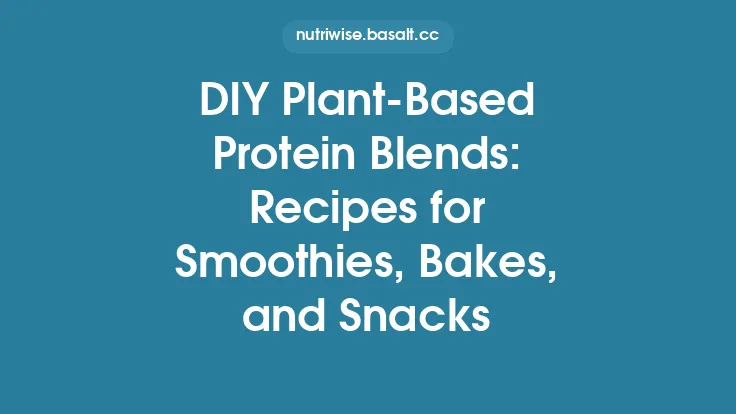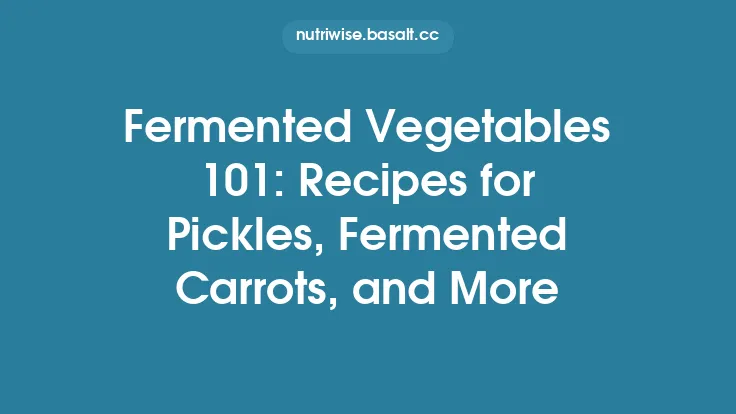When it comes to reducing single‑use plastic in the kitchen, few solutions are as satisfying—and as hands‑on—as making your own reusable food wraps. A well‑crafted wrap can keep sandwiches fresh, protect cheese from drying out, and even seal a bowl of leftovers without the need for cling film. By combining natural fibers with food‑grade waxes, oils, and resins, you create a barrier that is breathable enough to let foods stay crisp while still providing a moisture‑resistant seal. The result is a low‑cost, biodegradable alternative that can be customized to suit any aesthetic or functional need.
Why DIY Wraps Beat Store‑Bought Options
Material Transparency
Commercial beeswax wraps often list vague ingredients such as “beeswax, jojoba oil, and resin.” When you make your own, you know the exact source of each component—whether the wax comes from a local apiary, the oil is cold‑pressed, or the fabric is organic cotton. This transparency lets you avoid allergens, unwanted additives, or low‑grade waxes that can melt at lower temperatures.
Tailored Performance
Different foods demand different levels of breathability and moisture resistance. A wrap made with a higher wax‑to‑fabric ratio works well for cheese, while a lighter coating is better for wrapping fresh herbs. By adjusting the recipe, you can fine‑tune the wrap’s properties rather than settling for a one‑size‑fits‑all product.
Environmental Footprint
Even though many store‑bought wraps are marketed as “eco‑friendly,” the manufacturing process often involves energy‑intensive extrusion, transportation, and packaging. Homemade wraps eliminate most of these steps, especially when you source materials locally. The carbon emissions associated with a DIY wrap are typically limited to the energy used for heating the wax and the mileage of a short trip to a farmer’s market.
Cost Savings Over Time
A single roll of commercial beeswax wrap can cost $15–$20 and may last a few months with careful use. In contrast, a batch of homemade wraps—using a few dollars worth of fabric, wax, and oil—can produce dozens of sheets that last a year or more, delivering a clear financial advantage.
Core Materials and Their Functions
| Component | Role in the Wrap | Typical Sources | Key Properties |
|---|---|---|---|
| Fabric Base | Provides structural support and flexibility | Organic cotton, linen, hemp, bamboo canvas | High tensile strength, natural fibers are breathable and biodegradable |
| Beeswax | Forms the primary moisture barrier; solid at room temperature, softens at ~60 °C | Local beekeepers, bulk suppliers | Natural antimicrobial properties, low melting point for easy reshaping |
| Resin (e.g., pine, jojoba, or candelilla) | Increases tackiness and improves water resistance | Pine sap, jojoba oil (cold‑pressed), candelilla wax (plant‑derived) | Enhances adhesion to food surfaces, raises melting point slightly |
| Oil (e.g., coconut, almond, or grapeseed) | Softens the wax blend, prevents brittleness | Cold‑pressed, food‑grade oils | Improves flexibility, reduces cracking over repeated use |
| Optional Additives | Color, scent, extra antimicrobial activity | Natural pigments (turmeric, beetroot powder), essential oils (lavender, tea tree) | Customization without compromising safety |
Choosing the Right Fabric
- Cotton: The most common choice due to its softness, ease of washing, and wide availability. Look for tightly woven, pre‑shrunk fabric to avoid distortion after the first wash.
- Linen: Offers a slightly rougher texture, which can improve wax adhesion. It also dries faster than cotton.
- Hemp: Extremely durable and naturally resistant to mold, making it ideal for high‑use wraps.
- Bamboo Canvas: Provides a smooth surface and a subtle sheen, though it may be more expensive.
When selecting fabric, aim for a weight of 150–200 gsm (grams per square meter). Too light, and the fabric may tear; too heavy, and the wrap becomes stiff.
Understanding Wax Types
- Raw Beeswax: Contains natural pollen and propolis, which contribute to antimicrobial activity. It has a faint honey scent and a melting point around 62 °C.
- Filtered Beeswax: Stripped of pollen and debris, resulting in a cleaner appearance and a slightly higher melting point (≈64 °C). Preferred for those with pollen sensitivities.
- Candelilla Wax: Plant‑derived, harder than beeswax, and raises the overall melting point of the blend. Useful when you need a more heat‑resistant wrap.
- Soy Wax: Often used in commercial blends; it is softer and can lower the overall melting point, making the wrap more pliable at room temperature.
A balanced blend typically consists of 70–80 % beeswax, 10–15 % resin, and 10–15 % oil. Adjust these ratios based on the desired flexibility and temperature tolerance.
Step‑by‑Step Guide to Crafting Your First Batch
1. Prepare the Workspace
- Safety First: Use a double boiler or a heat‑proof bowl set over a pot of simmering water. This prevents direct flame contact, reducing the risk of scorching the wax.
- Ventilation: While natural waxes emit a pleasant aroma, ensure the area is well‑ventilated to avoid buildup of any fumes.
- Tools Needed:
- Digital kitchen scale (for precise measurements)
- Silicone brush or pastry brush
- Baking sheet lined with parchment or a silicone mat
- Scissors or rotary cutter
- Clean cloths for wiping excess wax
2. Cut the Fabric
- Measure and cut the fabric into squares or rectangles that suit your typical food items (e.g., 8 × 8 in for cheese, 12 × 12 in for sandwiches).
- Pre‑wash the fabric in hot water (no fabric softener) to remove any sizing agents that could interfere with wax adhesion.
- Dry completely—any residual moisture will cause the wax to pool unevenly.
3. Melt the Wax Blend
- Weigh the components according to your chosen ratio. For a starter batch:
- 100 g beeswax
- 15 g pine resin (or 10 g jojoba oil)
- 15 g coconut oil (or another food‑grade oil)
- Place the beeswax in the double boiler and allow it to melt fully.
- Add the resin and stir until dissolved.
- Finally, incorporate the oil, stirring continuously to achieve a uniform, glossy mixture.
Tip: If you want a tinted wrap, add a pinch of natural pigment (e.g., turmeric for yellow, beet powder for pink) at this stage. Ensure the pigment is fully dissolved to avoid streaks.
4. Coat the Fabric
- Using the silicone brush, apply a thin, even layer of the molten wax onto one side of the fabric.
- Work quickly; the wax will begin to solidify as it cools.
- For a more robust barrier, apply a second coat after the first has set (approximately 2–3 minutes).
- Flip the fabric and repeat on the opposite side if you desire a double‑sided wrap.
5. Set and Cure
- Place the coated fabric on the parchment‑lined sheet.
- Allow it to cool at room temperature for 10–15 minutes, then transfer to a refrigerator for an additional 5 minutes to ensure full solidification.
- Once hardened, gently press the wrap with a clean cloth to smooth out any unevenness.
6. Trim and Store
- Trim excess edges for a neat finish.
- Store the finished wraps in a cool, dry place away from direct sunlight. A simple cardboard box or a reusable fabric pouch works well.
Optimizing Performance for Different Food Types
Cheese and Charcuterie
- Higher Wax Ratio: Increase beeswax to 85 % of the blend to create a tighter seal that slows oxidation.
- Cool Storage: Keep wraps in the refrigerator; the cooler temperature keeps the wax more pliable and reduces the risk of cracking.
Fresh Herbs and Berries
- Breathability: Use a lighter coating (≈60 % beeswax) to allow moisture to escape, preventing sogginess.
- Layering: Pair the wrap with a breathable paper towel inside to absorb excess humidity.
Bread and Baked Goods
- Medium Wax Content: A 70 % beeswax blend offers enough barrier to keep crust crisp while allowing the crumb to stay soft.
- Wrap Orientation: Overlap the edges by at least 1 cm to create a seal that prevents air pockets.
Hot Foods (e.g., leftovers from the oven)
- Heat Resistance: Incorporate 5–10 % candelilla wax to raise the melting point to ~70 °C.
- Cooling First: Allow food to cool to below 50 °C before covering; this prevents the wax from softening excessively.
Care, Maintenance, and Longevity
Washing Guidelines
- Cool Water Rinse: Rinse the wrap under cool running water to remove food residue.
- Mild Detergent: Use a few drops of a gentle, fragrance‑free dish soap. Avoid harsh chemicals that can strip the wax.
- Gentle Scrub: A soft sponge or cloth is sufficient; avoid abrasive scrubbers.
- Air Dry: Hang the wrap to dry completely before storing. Do not tumble‑dry, as high heat can melt the wax.
Re‑Waxing Procedure
- Over time, the wax layer may wear thin, especially after frequent washes. To rejuvenate:
- Melt a small amount of your original wax blend.
- Brush a thin layer onto the clean, dry fabric.
- Allow to set as described in the “Set and Cure” step.
- Re‑waxing can extend the life of a wrap by an additional 6–12 months.
Signs of End‑of‑Life
- Cracking or Flaking: Indicates the wax has degraded beyond repair.
- Persistent Odor: If the wrap develops a sour or rancid smell despite cleaning, it may harbor microbial growth.
- Loss of Flexibility: When the fabric becomes stiff and no longer conforms to food shapes, it’s time to retire the wrap.
When a wrap reaches the end of its usable life, compost the fabric (if it’s 100 % natural) and recycle any metal or glass components used in the production process.
Exploring Alternatives Beyond Beeswax
While beeswax remains the classic choice, several other natural substances can serve as effective barriers, each with distinct advantages.
1. Plant‑Based Wax Blends
- Soy‑Candelilla Mix: Combines the softness of soy wax with the heat resistance of candelilla. Ideal for vegan kitchens or for those seeking a non‑animal source.
- Carnauba Wax: Extracted from Brazilian palm leaves, it yields a very hard, glossy finish. A small percentage (5–10 %) added to a beeswax base can dramatically increase durability.
2. Oil‑Infused Cloths
- Olive Oil & Beeswax Hybrid: Olive oil adds a pleasant aroma and extra pliability. The blend works well for wrapping items that will be consumed within a day.
- Almond Oil & Resin: Provides a nutty scent and a slightly higher smoke point, making it suitable for warm foods.
3. Resin‑Only Wraps (Vegan “Wax”)
- Pine Resin + Coconut Oil: When heated together, pine resin forms a tacky, semi‑solid coating that adheres well to fabric. This resin‑only approach eliminates animal products while still delivering a moisture barrier.
4. Biopolymer Coatings
- Chitosan (Derived from Crustacean Shells): Forms a thin, edible film with antimicrobial properties. When combined with a small amount of beeswax, it can enhance food safety.
- Agar‑Based Gels: Used as a secondary coating on top of a wax layer to add an extra barrier against oxygen.
Each alternative can be mixed and matched with different fabrics to create a personalized suite of wraps that meet specific dietary, ethical, or performance criteria.
Scaling Up: From Kitchen Project to Small‑Batch Production
If you find yourself making dozens of wraps each month, consider these efficiency upgrades:
- Large‑Scale Melting Vessel: A stainless‑steel pot with a temperature controller ensures consistent wax temperature, reducing the risk of scorching.
- Roller Coating System: Passing the fabric through a set of rollers dipped in molten wax yields an even, uniform coating without the need for brushing.
- Drying Rack with Low‑Heat Lamps: Speeds up the curing process while maintaining a gentle temperature that prevents premature melting.
- Batch Labeling: Use a small, water‑based stamp to imprint the date and wax composition on each wrap. This helps track longevity and re‑waxing schedules.
Even with modest equipment, a small home‑based operation can produce high‑quality wraps that rival commercial offerings while retaining the personal touch of handcrafted goods.
Safety and Regulatory Considerations
- Food‑Grade Materials: Ensure all waxes, oils, and resins are labeled “food‑grade” or “GRAS” (Generally Recognized As Safe) by relevant authorities.
- Allergen Awareness: Beeswax contains trace pollen; individuals with severe pollen allergies may need to opt for plant‑based alternatives.
- Temperature Limits: Do not expose wraps to temperatures above 80 °C (176 °F) for extended periods, as the wax may soften and transfer to food.
- Storage Conditions: Keep wraps away from direct sunlight and high humidity to prevent premature degradation of the wax layer.
Frequently Asked Questions
Q: Can I use these wraps for hot leftovers straight from the oven?
A: It’s best to let food cool to below 50 °C before covering. For higher‑heat applications, incorporate a small amount of candelilla or carnauba wax to raise the melting point.
Q: Are the wraps truly biodegradable?
A: Yes, when the fabric is 100 % natural (cotton, linen, hemp) and the waxes are plant‑ or animal‑derived, the entire wrap will break down in a compost environment within 6–12 months.
Q: How many times can I wash a single wrap?
A: With proper care, a well‑made wrap can endure 30–50 washes before the wax layer thins enough to require re‑waxing.
Q: Do the wraps affect the taste of food?
A: Beeswax and most natural oils impart a mild, pleasant aroma but do not alter the flavor of most foods. If you’re sensitive to these scents, choose a neutral oil like grapeseed and avoid scented additives.
Q: Can I use the same wrap for both sweet and savory items?
A: Absolutely. The barrier properties are food‑agnostic; just ensure the wrap is clean between uses to avoid cross‑contamination.
Final Thoughts
Creating your own eco‑friendly food wraps transforms a routine kitchen task into a purposeful act of sustainability. By mastering the interplay of fabric, wax, resin, and oil, you gain control over the performance, aesthetics, and environmental impact of each wrap. Whether you stick with classic beeswax or experiment with plant‑based alternatives, the process empowers you to reduce reliance on disposable plastics while adding a touch of handcrafted charm to everyday meals. With a little practice, a modest investment in materials, and a commitment to proper care, your DIY wraps can become a lasting staple in a kitchen that values both flavor and the planet.





